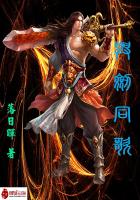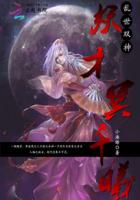The archdeacon, seeing that all his exertions served only to weaken the fragile support which remained to him, decided to remain quiet. There he hung, embracing the gutter, hardly breathing, no longer stirring, making no longer any other movements than that mechanical convulsion of the stomach, which one experiences in dreams when one fancies himself falling.His fixed eyes were wide open with a stare.He lost ground little by little, nevertheless, his fingers slipped along the spout; he became more and more conscious of the feebleness of his arms and the weight of his body.The curve of the lead which sustained him inclined more and more each instant towards the abyss.
He beheld below him, a frightful thing, the roof of Saint-Jean le Rond, as small as a card folded in two. He gazed at the impressive carvings, one by one, of the tower, suspended like himself over the precipice, but without terror for themselves or pity for him.All was stone around him; before his eyes, gaping monsters; below, quite at the bottom, in the Place, the pavement; above his head, Quasimodo weeping.
In the Parvis there were several groups of curious good people, who were tranquilly seeking to divine who the madman could be who was amusing himself in so strange a manner. The priest heard them saying, for their voices reached him, clear and shrill:“Why, he will break his neck!”
Quasimodo wept.
At last the archdeacon, foaming with rage and despair, understood that all was in vain.Nevertheless, he collected all the strength which remained to him for a final effort.He stiffened himself upon the spout, pushed against the wall with both his knees, clung to a crevice in the stones with his hands, and succeeded in climbing back with one foot, perhaps; but this effort made the leaden beak on which he rested bend abruptly. His cassock burst open at the same time.Then, feeling everything give way beneath him, with nothing but his stiffened and failing hands to support him, the unfortunate man closed his eyes and let go of the spout.He fell.
Quasimodo watched him fall.
A fall from such a height is seldom perpendicular. The archdeacon, launched into space, fell at first head foremost, with outspread hands; then he whirled over and over many times; the wind blew him upon the roof of a house, where the unfortunate man began to break up.Nevertheless, he was not dead when he reached there.The bellringer saw him still endeavor to cling to a gable with his nails; but the surface sloped too much, and he had no more strength.He slid rapidly along the roof like a loosened tile, and dashed upon the pavement.There he no longer moved.
Then Quasimodo raised his eyes to the gypsy, whose body he beheld hanging from the gibbet, quivering far away beneath her white robe with the last shudderings of anguish, then he dropped them on the archdeacon, stretched out at the base of the tower, and no longer retaining the human form, and he said, with a sob which heaved his deep chest, —“Oh!all that I have ever loved!”
Chapter3 The Marriage of Phoebus
Towards evening on that day, when the judiciary officers of the bishop came to pick up from the pavement of the Parvis the dislocated corpse of the archdeacon, Quasimodo had disappeared.
A great many rumors were in circulation with regard to this adventure. No one doubted but that the day had come when, in accordance with their compact, Quasimodo, that is to say, the devil, was to carry off Claude Frollo, that is to say, the sorcerer.It was presumed that he had broken the body when taking the soul, like monkeys who break the shell to get at the nut.
This is why the archdeacon was not interred in consecrated earth.
Louis XI. died a year later, in the month of August, 1483.
As for Pierre Gringoire, he succeeded in saving the goat, and he won success in tragedy. It appears that, after having tasted astrology, philosophy, architecture, hermetics, —all vanities, he returned to tragedy, vainest pursuit of all.This is what he called“coming to a tragic end.”This is what is to be read, on the subject of his dramatic triumphs, in 1483, in the accounts of the“Ordinary:”“To Jehan Marchand and Pierre Gringoire, carpenter and composer, who have made and composed the mystery made at the Chatelet of Paris, at the entry of Monsieur the Legate, and have ordered the personages, clothed and dressed the same, as in the said mystery was required; and likewise, for having made the scaffoldings thereto necessary; and for this deed, —one hundred livres.”
Phoebus de Chateaupers also came to a tragic end. He married.
Chapter4 The Marriage of Quasimodo
We have just said that Quasimodo disappeared from Notre-Dame on the day of the gypsy's and of the archdeacon's death. He was not seen again, in fact; no one knew what had become of him.
During the night which followed the execution of la Esmeralda, the night men had detached her body from the gibbet, and had carried it, according to custom, to the cellar of Montfaucon.
Montfaucon was, as Sauval says, “the most ancient and the most superb gibbet in the kingdom.”Between the faubourgs of the Temple and Saint Martin, about a hundred and sixty toises from the walls of Paris, a few bow shots from La Courtille, there was to be seen on the crest of a gentle, almost imperceptible eminence, but sufficiently elevated to be seen for several leagues round about, an edifice of strange form, bearing considerable resemblance to a Celtic cromlech, and where also human sacrifices were offered.
Let the reader picture to himself, crowning a limestone hillock, an oblong mass of masonry fifteen feet in height, thirty wide, forty long, with a gate, an external railing and a platform; on this platform sixteen enormous pillars of rough hewn stone, thirty feet in height, arranged in a colonnade round three of the four sides of the mass which support them, bound together at their summits by heavy beams, whence hung chains at intervals; on all these chains, skeletons; in the vicinity, on the plain, a stone cross and two gibbets of secondary importance, which seemed to have sprung up as shoots around the central gallows; above all this, in the sky, a perpetual flock of crows; that was Montfaucon.
At the end of the fifteenth century, the formidable gibbet which dated from 1328, was already very much dilapidated; the beams were wormeaten, the chains rusted, the pillars green with mould; the layers of hewn stone were all cracked at their joints, and grass was growing on that platform which no feet touched. The monument made a horrible profile against the sky; especially at night when there was a little moonlight on those white skulls, or when the breeze of evening brushed the chains and the skeletons, and swayed all these in the darkness.The presence of this gibbet sufficed to render gloomy all the surrounding places.
The mass of masonry which served as foundation to the odious edifice was hollow.A huge cellar had been constructed there, closed by an old iron grating, which was out of order, into which were cast not only the human remains, which were taken from the chains of Montfaucon, but also the bodies of all the unfortunates executed on the other permanent gibbets of Paris.To that deep charnel-house, where so many human remains and so many crimes have rotted in company, many great ones of this world, many innocent people, have contributed their bones, from Enguerrand de Marigni, the first victim, and a just man, to Admiral de Coligni, who was its last, and who was also a just man.
As for the mysterious disappearance of Quasimodo, this is all that we have been able to discover.
About eighteen months or two years after the events which terminate this story, when search was made in that cavern for the body of Olivier le Daim, who had been hanged two days previously, and to whom Charles VIII. had granted the favor of being buried in Saint Laurent, in better company, they found among all those hideous carcasses two skeletons, one of which held the other in its embrace.One of these skeletons, which was that of a woman, still had a few strips of a garment which had once been white, and around her neck was to be seen a string of adrez arach beads with a little silk bag ornamented with green glass, which was open and empty.These objects were of so little value that the executioner had probably not cared for them.The other, which held this one in a close embrace, was the skeleton of a man.It was noticed that his spinal column was crooked, his head seated on his shoulder blades, and that one leg was shorter than the other.Moreover, there was no fracture of the vertebrae at the nape of the neck, and it was evident that he had not been hanged.Hence, the man to whom it had belonged had come thither and had died there.When they tried to detach the skeleton which he held in his embrace, he fell to dust.
NOTE ADDED TO THE DEFINITIVE EDITION
It is by mistake that this edition was announced as augmented by many new chapters.The word should have been unpublished.In fact, if by new, newly made is to be understood, the chapters added to this edition are not new.They were written at the same time as the rest of the work; they date from the same epoch, and sprang from the same thought, they have always formed a part of the manu of“Notre-Dame-de-Paris.”Moreover, the author cannot comprehend how fresh developments could be added to a work of this character after its completion.This is not to be done at will.According to his idea, a romance is born in a manner that is, in some sort, necessary, with all its chapters; a drama is born with all its scenes.Think not that there is anything arbitrary in the numbers of parts of which that whole, that mysterious microcosm which you call a drama or a romance, is composed.
Grafting and soldering take badly on works of this nature, which should gush forth in a single stream and so remain. The thing once done, do not change your mind, do not touch it up.The book once published, the sex of the work, whether virile or not, has been recognized and proclaimed; when the child has once uttered his first cry he is born, there he is, he is made so, neither father nor mother can do anything, he belongs to the air and to the sun, let him live or die, such as he is.Has your book been a failure?So much the worse.Add no chapters to an unsuccessful book.Is it incomplete?You should have completed it when you conceived it.Is your tree crooked?You cannot straighten it up.Is your romance consumptive?Is your romance not capable of living?You cannot supply it with the breath which it lacks.Has your drama been born lame?Take my advice, and do not provide it with a wooden leg.
Hence the author attaches particular importance to the public knowing for a certainty that the chapters here added have not been made expressly for this reprint. They were not published in the preceding editions of the book for a very simple reason.At the time when“Notre-Dame-de-Paris”was printed the first time, the manu of these three chapters had been mislaid.It was necessary to rewrite them or to dispense with them.The author considered that the only two of these chapters which were in the least important, owing to their extent, were chapters on art and history which in no way interfered with the groundwork of the drama and the romance, that the public would not notice their loss, and that he, the author, would alone be in possession of the secret.He decided to omit them, and then, if the whole truth must be confessed, his indolence shrunk from the task of rewriting the three lost chapters.He would have found it a shorter matter to make a new romance.
Now the chapters have been found, and he avails himself of the first opportunity to restore them to their place.
This now, is his entire work, such as he dreamed it, such as he made it, good or bad, durable or fragile, but such as he wishes it.
These recovered chapters will possess no doubt, but little value in the eyes of persons, otherwise very judicious, who have sought in“Notre-Dame-de-Paris”only the drama, the romance.But there are perchance, other readers, who have not found it useless to study the aesthetic and philosophic thought concealed in this book, and who have taken pleasure, while reading“Notre-Dame-de-Paris, ”in unravelling beneath the romance something else than the romance, and in following, the system of the historian and the aim of the artist through the creation of the poet.
For such people especially, the chapters added to this edition will complete“Notre-Dame-de-Paris, ”if we admit that“Notre-Dame-de-Paris”was worth the trouble of completing.
In one of these chapters on the present decadence of architecture, and on the death of that king of arts, the author expresses and develops an opinion unfortunately well rooted in him, and well thought out. But he feels it necessary to say here that he earnestly desires that the future may, some day, put him in the wrong.He knows that art in all its forms has everything to hope from the new generations whose genius, still in the germ, can be heard gushing forth in our studios.The grain is in the furrow, the harvest will certainly be fine.He merely fears, and the reason may be seen in the second volume of this edition, that the sap may have been withdrawn from that ancient soil of architecture which has been for so many centuries the best field for art.
Nevertheless, there are to-day in the artistic youth so much life, power, and, so to speak, predestination, that in our schools of architecture in particular, at the present time, the professors, who are detestable, produce, not only unconsciously but even in spite of themselves, excellent pupils; quite the reverse of that potter mentioned by Horace, who dreamed amphorae and produced pots. Currit rota, urcens exit.
But, in any case, whatever may be the future of architecture, in whatever manner our young architects may one day solve the question of their art, let us, while waiting for new monument, preserve the ancient monuments. Let us, if possible, inspire the nation with a love for national architecture.That, the author declares, is one of the principal aims of this book; it is one of the principal aims of his life.
“Notre-Dame-de-Paris”has, perhaps opened some true perspectives on the art of the Middle Ages, on that marvellous art which up to the present time has been unknown to some, and, what is worse, misknown by others.But the author is far from regarding as accomplished, the task which he has voluntarily imposed on himself.He has already pleaded on more than one occasion, the cause of our ancient architecture, he has already loudly denounced many profanations, many demolitions, many impieties.He will not grow weary.He has promised himself to recur frequently to this subject.He will return to it.He will be as indefatigable in defending our historical edifices as our iconoclasts of the schools and academies are eager in attacking them; for it is a grievous thing to see into what hands the architecture of the Middle Ages has fallen, and in what a manner the botchers of plaster of the present day treat the ruin of this grand art, it is even a shame for us intelligent men who see them at work and content ourselves with hooting them.And we are not speaking here merely of what goes on in the provinces, but of what is done in Paris at our very doors, beneath our windows, in the great city, in the lettered city, in the city of the press, of word, of thought.
We cannot resist the impulse to point out, in concluding this note, some of the acts of vandalism which are every day planned, debated, begun, continued, and successfully completed under the eyes of the artistic public of Paris, face to face with criticism, which is disconcerted by so much audacity.An archbishop's palace has just been demolished, an edifice in poor taste, no great harm is done; but in a block with the archiepiscopal palace a bishop's palace has been demolished, a rare fragment of the fourteenth century, which the demolishing architect could not distinguish from the rest.He has torn up the wheat with the tares; 'tis all the same.They are talking of razing the admirable chapel of Vincennes, in order to make, with its stones, some fortification, which Daumesnil did not need, however.While the Palais Bourbon, that wretched edifice, is being repaired at great expense, gusts of wind and equinoctial storms are allowed to destroy the magnificent painted windows of the Sainte-Chapelle.
For the last few days there has been a scaffolding on the tower of Saint Jacques de la Boucherie; and one of these mornings the pick will be laid to it.A mason has been found to build a little white house between the venerable towers of the Palais de-Justice.Another has been found willing to prune away Saint-Germain-des-Pres, the feudal abbey with three bell towers.Another will be found, no doubt, capable of pulling down Saint-Germain l'Auxerrois.All these masons claim to be architects, are paid by the prefecture or from the petty budget, and wear green coats.All the harm which false taste can inflict on good taste, they accomplish. While we write, deplorable spectacle!one of them holds possession of the Tuileries, one of them is giving Philibert Delorme a scar across the middle of his face; and it is not, assuredly, one of the least of the scandals of our time to see with what effrontery the heavy architecture of this gentleman is being flattened over one of the most delicate fa?ades of the Renaissance!
PARIS, October 20, 1832.
注释
[1]这是但丁的诗句, 意大利文.















